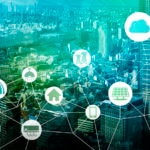What are smart cities?
New York, Oslo, Vitoria or Bogotá… The world’s largest - and not so large – cities compete to be recognized as the ‘smartest’. But, what exactly is a ‘smart city’? Cities are trying to innovate to improve the living standards of their inhabitants

A Smart city is defined as a complex and interconnected system that applies new technologies to manage everything, from the proper running of public and private transport systems, and the efficient use of power or water resources, civil protection plans, to socio-economic aspects, such as the vitality of public spaces and the commercial fabric, or the notification of incidences to visitors and citizens.
"A smart city detects its citizens’ needs and reacts to their demands transforming the way in which they interact with the public service systems and elements through knowledge. Thus, the city bases and plans for its actions building on this knowledge, ideally in real-time, or even acting before these needs arise”, says Juan Murillo, head of Territorial Analysis of BBVA Data & Analytics.
According to a report by consulting firm Deloitte on the topic, the design of a smart city can be tackled at different non-exclusive levels: environment, mobility, governance, economy, people and housing. Of course, true smart metropolises adopt combined approaches to address these categories simultaneously, to become as efficient and ecological as possible.
Cities, little by little, are making progress in the different fronts. Today, more and more cities are building integral service platforms, releasing their own applications for tourists, citizens and merchants publicizing the city’s activities, deploying special SME support programs (such as urban Living Labs) and implementing more environmental friendly initiatives.
Real-life examples
To find out which cities are the most advanced, IESE publishes a yearly report entitled IESE Cities in Motion. In 2016, the report concluded that New York was the world’s smartest city, followed by London and Paris. However, social cohesion and pollution levels were, and still are, the big pending issues for the three finalists.

Discover whether your city is a smart city with this interactive map - IESE Business School
New York, London and Paris are, indeed, great cities that are facing challenges on par with their huge scale, which means that, at the time of rolling out measures to make them smarter, things get a bit more complicated.. Juan Murillo likes to point at cities that are more manageable in size: “Oslo, Vienna, Amsterdam or Copenhagen are wonderful examples of urban innovation, and more importantly, the metrics measuring their citizens’ living standards also reflect this.”
Amsterdam, known for canals and coffee shops, is rolling out multiple smart projects, including ‘smart light’. Developed by Cisco, A2, Philips, Alliander and KPN, the project envisages the deployment and maintenance of a public lighting system equipped with special sensors to regulate lighting intensity remotely, thus yielding significant energy savings.
Copenhagen brims not only with happiness -hygge for Danes – but also with clean air. The Danish government is aiming to get 50% of its electricity from wind by 2020. As part of this goal, in 2000 the country started investing in the development of Middelgrunden, an offshore wind farm that will eventually be able to generate enough power to cover the city’s needs.
When implementing the sustainability model that smart cities promote, it is possible to distinguish between two stages: the technological innovation stage, where Asian cities such as Singapore have taken the lead, and the stage at which behavior patterns are changed, especially in terms of mobility.
Many large cities across the world have already started deploying zero-cost – in terms of emissions for the planet - mobility initiatives. Bogota with its EBus Andino 18, Madrid with its electric mini-buses, Barcelona, Melbourne, Berlin, Paris… Little by little, mobility is becoming more sustainable and environmental-friendly. Even waste collection services are starting to become smarter. Compology, a San Francisco startup is developing sensors for waste containers. The solution that Compology proposes entails the use of compressors capable of detecting and providing information about the amount of trash in the containers, based on which garbage truck routes are organized, thus saving costs.
In Spain, besides Madrid and Barcelona, the country’s largest cities, other smaller towns are rolling out a number initiatives. “Vitoria and Pamplona are examples of sustainable cities, that were already recognized as such long before smart became such a hot topic,” says Murillo, who considers that a city’s smartness should not be measured only by the budgets they manage or the technologies they implement, but by the quality of life they are capable of offering to their inhabitants.